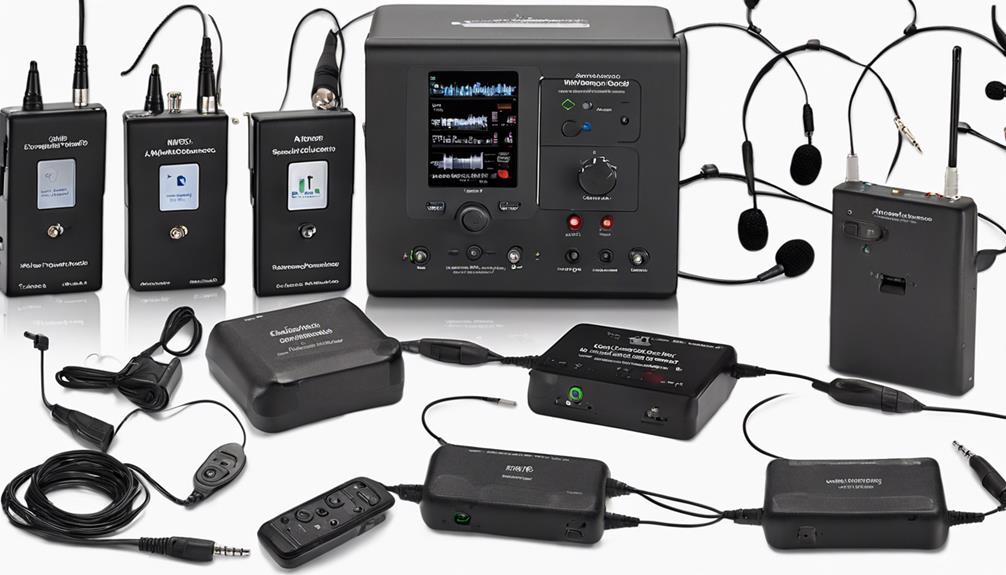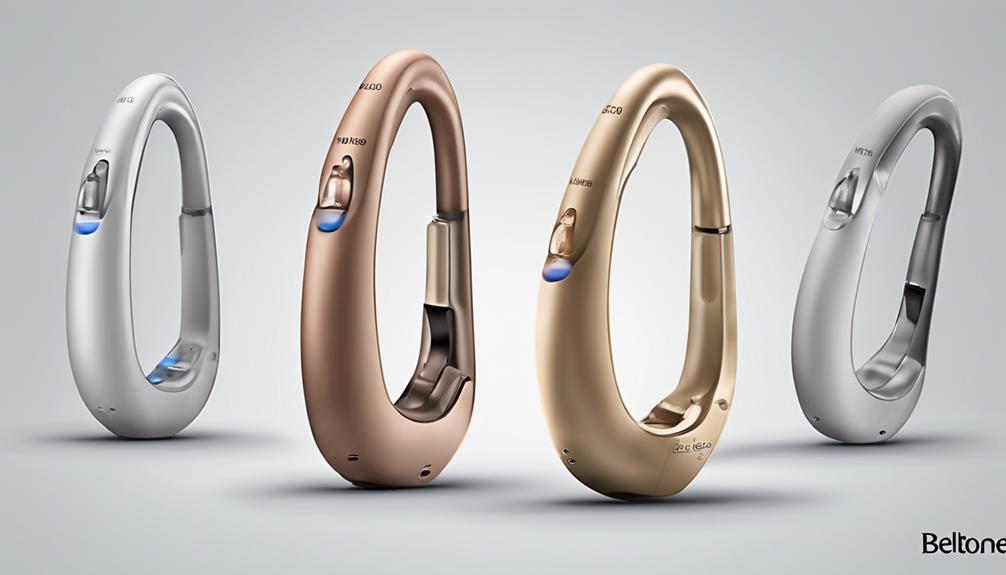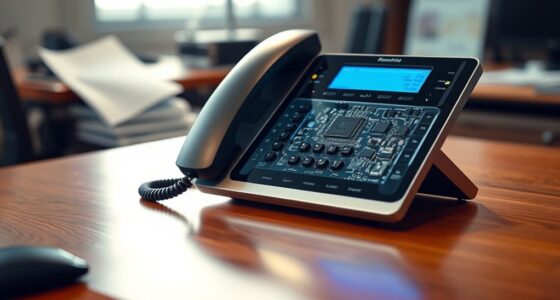Assistive listening devices act as a beacon of inclusivity in the sea of sound, ensuring that the message reaches every member of the congregation loud and clear.
But which devices make the cut as the top 7 for churches? Let's explore how these innovative tools can transform the worship experience and make a real difference for those in need of a little extra auditory assistance.
Key Takeaways
- Assistive Listening Systems like Hearing Loops and FM Systems meet ADA requirements effectively.
- Specialized Listening Devices such as Infrared Devices and Personal Amplifiers cater to diverse church settings.
- Audio Streaming Solutions offer wireless connectivity and closed captioning for an inclusive worship experience.
- Portable Systems feature mobility, easy setup, and clear sound quality, enhancing congregational auditory engagement.
Hearing (Induction) Loops
When considering solutions to improve sound clarity and accessibility in churches, installing hearing (induction) loops emerges as a vital step. Hearing loops are essential in meeting ADA requirements for accommodating individuals with hearing impairments in churches. These loops work by creating a magnetic field that's picked up by the telecoil in the user's hearing aid or cochlear implant, providing a clear and direct audio signal. Situating oneself within the loop perimeter is crucial for optimal reception, ensuring that the sound is effectively transmitted to the user's device.
However, the effectiveness of induction loops may diminish if the speakers are positioned too far from the loop or podium. In churches, the installation of induction loops is a cost-effective and efficient way to enhance the auditory experience for individuals with hearing loss. This provides them with the opportunity to fully engage in religious services and activities.
FM Assistive Listening System

FM assistive listening systems, with their expansive coverage of up to 1,000 feet, provide an effective solution for enhancing accessibility in large churches. These systems are designed to comply with the Americans with Disabilities Act (ADA) regulations, ensuring clear audio transmission to individuals with hearing impairments. FM assistive listening systems are easy to install, requiring no extensive remodeling, and seamlessly integrate with existing church sound systems. They offer a cost-effective option for churches seeking to improve inclusivity during services and events. These systems work efficiently both indoors and outdoors, making them versatile for various church layouts and activities. With the ability to transmit signals through ceilings, FM assistive listening systems ensure optimal coverage, allowing congregants to hear sermons, music, and speeches with clarity.
| Features | Description | Benefits |
|---|---|---|
| Expansive Coverage | Up to 1,000 feet range for accessibility in large churches | Ensures clear audio for congregants |
| Easy Integration | Seamless connection with existing sound systems | Simplifies installation process |
| Versatile Usage | Works indoors, outdoors, and through ceilings | Provides flexibility in different environments |
Infrared Listening Devices
Infrared listening devices, utilizing infrared light to transmit audio signals, offer a secure and confidential solution for delivering sound to listeners in churches. These devices are particularly beneficial in crowded environments where maintaining secure transmission is essential.
Here are key features of infrared listening devices:
- Secure Transmission: Infrared technology ensures that the audio signals are transmitted securely, making it an ideal choice for situations where confidentiality is paramount.
- Direct Line of Sight: To function effectively, infrared systems require a direct line of sight between the transmitter and the receiver. This direct communication path helps prevent signal interference and ensures clear audio delivery.
- Ideal for Crowded Environments: Infrared listening devices excel in crowded environments where maintaining the integrity of the audio signal is crucial. By using light to transmit data, they offer a reliable solution for churches with large congregations.
Personal Amplifiers

In the realm of assistive listening devices for churches, personal amplifiers like the Enersound PA-200 stand out as portable solutions providing clear sound amplification for congregants with hearing difficulties. These devices offer a lightweight and convenient way to enhance the audio experience during services.
The Enersound PA-200 Personal Waistband Amplifier, known for its multiple color options, caters to various personal preferences within congregations. Designed for ease of use, these personal amplifiers ensure that individuals with hearing impairments can fully engage in religious ceremonies. Their portability allows for seamless integration into different church settings without being obtrusive.
Moreover, the long-lasting battery life of personal amplifiers guarantees uninterrupted sound amplification throughout the duration of services. Churches looking to provide inclusive environments for all members of their congregation can rely on personal amplifiers to deliver enhanced sound quality and accessibility.
Audio Streaming Devices
Audio streaming devices seamlessly connect sound systems to smartphones, enhancing accessibility and providing congregants with a better listening experience during church services. These devices are crucial components of an assistive listening system, especially for individuals who rely on smartphones for their everyday tasks.
Here are three key aspects to consider:
- Wireless Connectivity: Audio streaming devices enable a wireless connection between the church's sound system and congregants' smartphones. This feature allows individuals to adjust the volume according to their preferences, ensuring a personalized listening experience.
- Live Streaming Services: Through audio streaming devices, congregants can access live streaming services during church gatherings. This functionality is especially beneficial for individuals who may have difficulty hearing the sermon or music directly in the church setting.
- Closed Captioning Integration: Some audio streaming devices support closed captioning, displaying service programs and lyrics on smartphones. This inclusion enhances accessibility for those with hearing loss, ensuring that everyone can actively participate in the church service.
Bluetooth Hearing Aids

Bluetooth hearing aids revolutionize the way individuals experience audio by enabling direct streaming from various devices such as smartphones and TVs. These assistive devices offer a seamless listening experience, allowing users to adjust volume and settings discreetly through dedicated smartphone apps.
The integration of Bluetooth technology enhances sound quality, reducing background noise and ensuring clearer audio for users. One of the significant advantages of Bluetooth hearing aids is the ability to effortlessly switch between different audio sources without the need for extra accessories, providing convenience and flexibility.
Modern hearing aids are increasingly equipped with Bluetooth connectivity to improve overall functionality and user experience. By leveraging Bluetooth technology, individuals can enjoy a more personalized and enhanced auditory experience, making these devices a valuable asset for those in need of assistive listening solutions.
Portable Assistive Listening Systems

Portable assistive listening systems utilize wireless transmission technology to seamlessly connect the main sound system to wireless receivers for congregants. These systems guarantee clear audio quality, offering individuals with hearing impairments the ability to fully engage in church services across different areas with minimal effort.
These systems ensure easy setup and use, making them a convenient and effective solution for creating an inclusive worship environment.
Wireless Transmission Technology
Utilizing advanced wireless transmission technology, portable assistive listening systems offer unparalleled mobility and clear audio delivery for churchgoers. These systems are designed to enhance the auditory experience in churches with dynamic seating arrangements, ensuring that every listener can hear the message clearly.
Here are three key features of portable assistive listening systems using wireless transmission:
- Wireless Receivers: Portable receivers allow church attendees to move freely within the system's range while receiving high-quality audio without being tethered by cables.
- Sound Source Connection: The transmitter connects to the main sound source, transmitting the audio wirelessly to the receivers for seamless distribution.
- Flexibility: Portable systems are ideal for churches with varying layouts or multiple event locations, providing flexibility for different congregational setups.
Easy Setup and Use
When setting up portable assistive listening systems in churches, ensuring ease of use is paramount to enhancing the congregational auditory experience. Portable systems are designed to be user-friendly, making them ideal for congregants with hearing challenges. These systems offer clear sound quality, ensuring that every word spoken during services is easily understood.
Their lightweight nature allows for easy transportation between different areas of the church, providing flexibility in accommodating various seating arrangements. Churches of all sizes can benefit from these portable systems, as they offer a quick and efficient solution for assisted listening. With their straightforward setup process, these systems can be operational in no time, contributing to a seamless auditory experience for all attendees.
Clear Audio Quality
Achieving optimal sound quality in churches for individuals with hearing loss is crucial, and portable assistive listening systems excel in delivering crystal clear audio transmission.
Best Portable Assistive Listening Systems for Clear Audio Quality:
- Lightweight Design: Portable systems are easy to carry around the church, ensuring accessibility in various areas without compromising on sound quality.
- Crystal Clear Sound Transmission: These systems offer clear audio quality, enhancing the worship experience for all congregants, including those with hearing loss.
- Discreet Use: The compact design of portable systems allows for discreet placement, ensuring that individuals can benefit from clear audio without drawing attention to the device.
Frequently Asked Questions
What Is the Most Commonly Used Assistive Listening Device?
The most commonly used assistive listening device is the FM system. It offers a range, simplicity, and cost-effectiveness that make it a popular choice.
An FM system consists of an FM transmitter connected to the main PA system and wireless receivers. This setup ensures crystal clear sound quality for individuals with hearing challenges.
Many churches widely adopt FM systems to guarantee accessibility during services.
How Can I Help Hard of Hearing in Church?
To help those hard of hearing in church, we focus on maximizing accessibility. Implementing hearing loops, portable induction loops, and external microphone connectors can enhance sound clarity for individuals with hearing loss. Additionally, utilizing wireless FM systems and visual assistive technologies like closed captioning on screens can ensure congregants with hearing challenges can fully engage in services.
What Is an FM Assistive Listening Device?
FM assistive listening devices are wireless systems that use FM technology to transmit audio signals. They've a wide range, up to 1,000 feet, making them suitable for large venues like churches. These systems are cost-effective, easy to install, and can be seamlessly integrated with existing sound systems.
Listeners can use portable receivers to tune in to the FM signal, ensuring clear sound quality. FM devices offer flexibility for indoor, outdoor, and even ceiling-through usage.
What Devices Help With Listening?
We find that hearing loops, external microphone connectors, FM assistive systems, closed captioning, and audio streaming over WiFi are essential devices for improving listening experiences in churches.
These tools directly transmit sound to hearing aids, connect multiple users with hearing loss, and display service programs for enhanced accessibility.
Conclusion
In conclusion, these top 7 assistive listening devices for churches are truly revolutionary in enhancing the worship experience for congregants with hearing impairments.
With crystal clear sound quality and seamless integration, these devices make it feel like you're sitting front row at a concert, even in the back pew.
Say goodbye to straining to hear the message and hello to a truly inclusive and accessible church environment.











